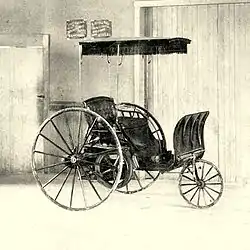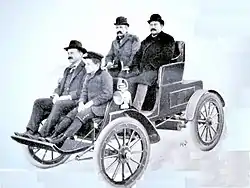John William Lambert
John William Lambert (1860 – 1952) was an American automobile manufacturer pioneer and inventor. He is the inventor of the first practical American gasoline automobile. He operated large manufacturing companies that made transmissions, stationary gas engines, farm tractors, commercial motor trucks, railroad inspection vehicles, and various gasoline driven street cars. He had over 600 inventions.
John William Lambert | |
|---|---|
 | |
| Born | January 29, 1860 |
| Died | May 20, 1952 (aged 92) Anderson, Indiana |
| Resting place | East Maplewood Cemetery |
| Nationality | American |
| Occupation | Mechanical Engineer |
| Known for | America's First Successful Gasoline Automobile and the Father of the Gradual Transmission |
| Spouse(s) | Mary (Minnie) F. Kelley married 1885 |
| Children | Alvin Ray and Ethel Mae |
| Parent(s) | George Lambert Anna Lambert parents from Pennsylvania |
Early life
Lambert was born on January 29, 1860, in Champaign County, Ohio. His parents were George Lambert and Anna (Liber) Lambert. They were both natives of Pennsylvania and pioneers of Ohio. Lambert was the third child of ten children in the family.[1] He received his education in the local public schools where he grew up as a child.[2]
Lambert's father took him on a trip one day in 1876 to a tannery to see an engine that ran without a steam boiler to operate. Upon arriving he was greatly disappointed when he discovered the building had burned down the night before. He was curious about the engine he was supposed to have seen in operation, being the only one he had a chance to actual see, so investigated among the still-warm ashes and ruins to find the burned engine. He found it and did examination of its parts to figure out how it worked. It was a slide valve coal gas engine.[3][4]
Mid life
Lambert and his brothers in 1885 moved to Union City, Ohio. There he went into a partnership arrangement with his father and formed an agricultural implement enterprise called J.W. Lambert & Company. The company made and sold farm equipment. After a few years doing this he relocated to Ohio City, Ohio There he operated a farm equipment store, lumber yard, and grain elevator business. He also owned commercial real estate that included the town's opera house and the town hall.[4][5]

first workable American gasoline one made.
Lambert in 1890 got involved in financing the development of a three-cylinder gasoline engine designed by John B. Hicks, a mechanical engineer inventor of Cleveland, Ohio. His initial investment was $200 (equivalent to $6,000 in 2019) and more was needed as time went on. Lambert supplied the increments needed until he had given Hicks $3300 (equivalent to $98,000 in 2019). Lambert made a written agreement with Hicks on the engine for a license to manufacture it with whatever modifications he felt necessary. He used Hick's engineers then to further develop the engine by his redesign. The parts that needed machine work was done by Lowell Machine Company. Lambert removed two cylinders and it became a one-cylinder engine. The engine was still not operating entirely correct after alterations and he had the unfinished engine and its components shipped to him from Cleveland to Ohio City in January 1891. There he further altered the engine and made it operational and innovated a special carburetor to operate the upgraded engine.[4][6]

Lambert designed and started construction of a three-wheel carriage vehicle also during January in Ohio City.[5] Before the end of the month he finished the three-wheel buggy and installed his light-weight engine on it for propulsion. He successfully test drove the self-propelled buggy then inside the 80-foot (24 m) farm equipment showroom he owned and managed in Ohio City. He made some changes to the hand steering lever controlling the front wheel, making it a stirrup-type operated by the feet instead.[4][7]
Lambert made sales brochures that he mailed out in the first part of February to sell versions of it for $550 (equivalent to $16,000 in 2019).[8] He started doing some experimental driving with America's first gasoline automobile on the streets of Ohio City later in the month.[5][8] The vehicle he had drawn up by a German architectural draftsman of Cleveland named William Watcholtz, who was one of Hick's engineers.[3][4] The tri-wheeled automobile was with 48 inch rear wheels and a 24-inch front center wheel by which it was steered using foot pedals.[9] It had wooden wheels with steel tires and could carry two passengers. The vehicle carburetor that Lambert designed he patented in 1902.[10] He had inquires for more information of his buggy automobile, but made no sales.[4][11]

in 1902 in a Union Automobile.
The Lambert gasoline engine propelled buggy was the first practical gasoline automobile made in the United States that could be driven on roads.[7][9][12] There were about 300 horseless carriages built up to 1895,[4] but Lambert was the first with a functional working automobile that he created in 1891.[5][13][14] He had beat Henry Ford by five years in producing a workable functional gasoline automobile.[15] The original three wheel car was destroyed in a building fire where he had it stored, however photographs were taken of it that did survive.[3][16]
Lambert in 1893 relocated to Anderson, Ohio. He moved some of his machinery from Ohio City to Anderson. The new facility of brick buildings consisted of six acres. He employed 250 people. It became the Buckeye Manufacturing Company and the Lambert Gas and Gasoline Engine Company. The facility updated its equipment to manufacture automobiles in 1902, becoming the Union Automobile Company.[4][9] Lambert's father was the president and he was the treasurer and general manager.[2]
He is recognized by the Smithsonian Institute as the inventor of America's first gasoline powered car.[16][17] The institute's museum and research center collections department holds several documents and photographs in Washington, D.C., that have been used by historians over the years to determine Lambert's gasoline buggy, also called the Buckeye gasoline buggy, as the first operational gasoline automobile made in the United States.[18] He is also credited with the first American automobile accident.[19] One time, he was testing his horseless carriage and drove it into a tree stump and accidentally ran into a hitching post. Lambert was driving the gasoline powered vehicle at the time and carrying a passenger by the name of James Swoveland, a local businessman that operated the city's drug store.[4][20]
There was a great deal of secrecy surrounding the development of his automobile. Operational tests were conducted with the window blinds pulled at the farm implement showroom barn where he ran it. Outside road tests were conducted at night on roads that were not used. That was a good thing, since many times there were long intervals between being able to get the automobile started again after it stopped. It turned out that the villagers didn't even know what Lambert was working on since it was such a new concept. They didn't realize the significance of Lambert's horseless carriage.[20]

Innovations
- Invented the first gasoline engine automobile in the United States.[4][21]
- Patented a friction transmission which was a gearless transmission.[22]
- Held over 600 patents in his career, most to do with the automobile.[20][21][23]
- Registered his first patent in 1876 when he was 16, on a corn seeder that revolutionized farming.[1][21][23]
Personal life
Lambert married Mary F Kelly in 1884. She was from Ansonia, Ohio They had two sons, E Moe and Roy, who were associated with him in business.[2]
Later life and legacy
Lambert died in Anderson, Indiana, on May 20, 1952.[20] Lambert Days is a community celebration that honors the life of John W. Lambert, the first gasoline-powered single-cylinder vehicle, and the world's first car wreck. This is an annual three-day event that takes place in Ohio City, Ohio, on the third weekend of July. Activities and events include a car show, art festival, flea market, sporting events, parade, live entertainment, and Lambert automobile displays.[24]
See also
References
- "A Brief Biography of John William Lambert". Retrieved December 18, 2020.
- Forkner 1914, p. 385.
- Dolmar, Hugh (1906). "The Lambert, 1906 Line of Automobiles". Automobile Trade Journal. Chilton Company. 10: 225.
- Bailey, L. Scott (1960). "Historic Discovery: 1891 Lambert, New Claim for America's First Car" (PDF). Antique Automobile magazine. Vol. 24 no. 5. Heuss Printing. pp. 342–347.
- Anthony Harrigan (December 27, 1976). "American Automobile Changed Our Lives". The Brownsville Herald. Brownsville, Texas. p. 6 – via Newspapers.com
 .
. - "Ray Lambert's Essay on his Father's First Car". Retrieved December 18, 2020.
- Madden 2003, p. 2.
- "American's First Gas Auto". The Cincinnati Enquirer. Cincinnati, Ohio. October 20, 1960. p. 76 – via Newspapers.com
 .
. - "Something New Under the Sun, The History of America's First Car". Retrieved December 10, 2020.
- Lucendo 2019, p. 1862.
- Lucendo 2019, p. 1863.
- Smith 2002, p. 62.
- Benton 1983, p. 517.
- "History of cars: [computimes, 2* edition]. New Straits Times". October 4, 2004. Retrieved December 12, 2020.
- James 2005, p. 6.
- "Lamberts to lead Bicentennial Parade". Anderson Herald. Anderson, Indiana. May 30, 1976. p. 3 – via Newspapers.com
 .
. - Henry 2016, p. 123.
- Keeran, Joshua. "Gas Car Pioneer". Daily Citizen newspaper. Retrieved December 10, 2020.
- newspaper clip "Oldest Resident of Ohio City" "Death Claims 1st Passenger of gasoline auto"
- "John W. Lambert". Ohio History Central. Retrieved 6 December 2020.
- "John W. Lambert". Anderson Herald. Anderson, Indiana. May 22, 1952. p. 4 – via Newspapers.com
 .
. - Indianapolis Star, March 22, 1914, p.18.
- "John Lambert dies at home". Anderson Herald. Anderson, Indiana. May 21, 1952. p. 1 – via Newspapers.com
 .
. - Mosier, Dave. "Lambert Days 2013". The Van Wert Independent. Retrieved December 11, 2020.
Sources
- Benton, William, ed. (1983). "John William Lambert". The New Encyclopedia Britannica. 2. New York City: Encyclopedia Britannica.
- Forkner, John La Rue (1914). History of Madison County, Indiana. Chicago, Illinois: Lewis Publishing Company.
- Henry, Mike (2016). What They Didn't Teach You in American History Class. Lanham, Maryland: Rowman & Littlefield Publishers. ISBN 9781475815481.
- James, Wanda (2005). Driving from Japan. Jefferson, North Carolina: McFarland Publishing Company. ISBN 0-7864-1734-X.
- Lucendo, Jorge (2019). Cars of Legend. McFarland & Company.
- Madden, W. C. (2003). Haynes=Apperson and America's First Practical Automobile. Jefferson, North Carolina: McFarland & Company. ISBN 0-7864-1397-2.
- Smith, John Martine (2002). Auburn - The Classic City. Arcadia Publishing. ISBN 9780738524016.